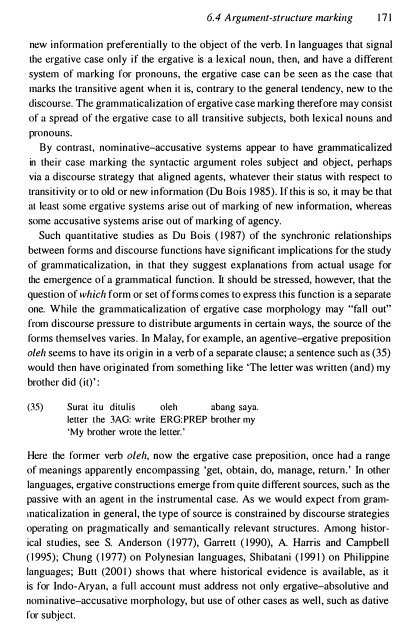Gram - SEAS
Gram - SEAS
Gram - SEAS
Create successful ePaper yourself
Turn your PDF publications into a flip-book with our unique Google optimized e-Paper software.
6.4 Argument-structure marking 171<br />
new information preferentially to the object of the verb. In languages that signal<br />
the ergative case only if the ergative is a lexical noun, then, and have a ditTerent<br />
system of marking for pronouns, the ergative case can be seen as the case that<br />
marks the transitive agent when it is, contrary to the general tendency, new to the<br />
discourse. The grammaticalization of ergative case marking therefore may consist<br />
of a spread of the ergative case to all transitive subjects, both lexical nouns and<br />
pronouns.<br />
By contrast, nominative-accusative systems appear to have grammaticalized<br />
in their case marking the syntactic argument roles subject and object, perhaps<br />
via a discourse strategy that aligned agents, whatever their status with respect to<br />
transitivity or to old or new information (Du Bois 1985). If this is so, it may be that<br />
at least some ergative systems arise out of marking of new information, whereas<br />
some accusative systems arise out of marking of agency.<br />
Such quantitative studies as Du Bois (1987) of the synchronic relationships<br />
between forms and discourse fu nctions have significant implications for the study<br />
of grammaticalization, in that they suggest explanations from actual usage for<br />
the emergence of a grammatical fu nction. It should be stressed, however, that the<br />
question of which form or set of forms comes to express this function is a separate<br />
one. While the grammaticalization of ergative case morphology may "fall out"<br />
from discourse pressure to distribute arguments in certain ways, the source of the<br />
forms themselves varies. In Malay, for example, an agentive-ergative preposition<br />
aleh seems to have its origin in a verb of a separate clause; a sentence such as (35)<br />
would then have originated from something like 'The letter was written (and) my<br />
brother did (it)':<br />
(35) Surat itu ditulis oleh abang saya.<br />
letter the 3AG: write ERG:PREP brother my<br />
'My brother wrote the letter. '<br />
Here the former verb aleh, now the ergative case preposition, once had a range<br />
of meanings apparently encompassing 'get, obtain, do, manage, return.' In other<br />
languages, ergative constructions emerge from quite different sources, such as the<br />
passive with an agent in the instrumental case. As we would expect from grammaticalization<br />
in general, the type of source is constrained by discourse strategies<br />
operating on pragmatically and semantically relevant structures. Among historical<br />
studies, see S. Anderson (1977), Garrett (1990), A. Harris and Campbell<br />
(1995); Chung (1977) on Polynesian languages, Shibatani (1991) on Philippine<br />
languages; Butt (200 I) shows that where historical evidence is available, as it<br />
is for Indo-Aryan, a full account must address not only ergative-absolutive and<br />
nominative-accusative morphology, but use of other cases as well, such as dative<br />
for subject.
















